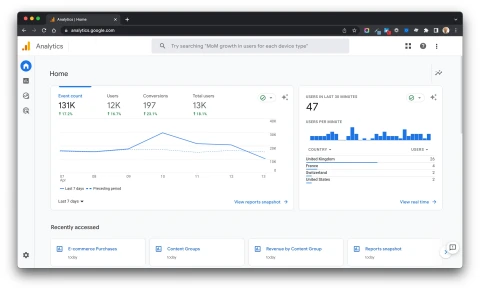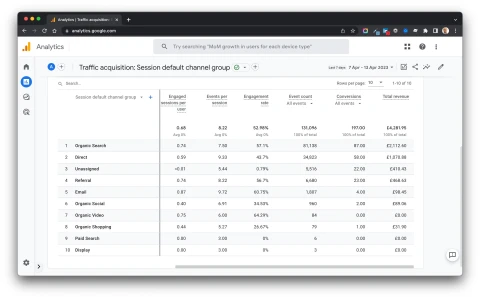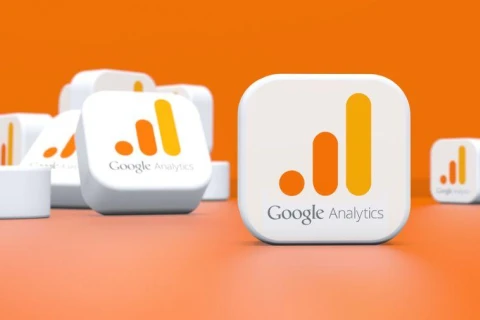Common Questions asked about migrating to GA4 (Google Analytics 4)
—If you’re responsible for tracking your organisation's digital progress and one of your data sources is Google Analytics (GA), you’ve probably seen a notice in your analytics dashboard warning that Universal Analytics (UA) will no longer process new data beginning in July 2023. GA4 is a step change in both data capture and reporting, so building a plan now will smooth your migration and help to maintain the integrity of your data.
More than likely, and if you’re anything like most internet users, you’ll have barely read the notice the first few times and hit “dismiss” almost automatically, right up until the point where you realised that 2023 is no longer a vague and far-off concept, but a section of your calendar that you will be using alarmingly soon.
Hitting the “Let’s go” button and setting up your new GA4 property sounds easy, and the sooner that gets done, the less painful the switchover will be. However, the process isn’t as simple as a one-click upgrade.
Have you started your transition to GA4?
Take our online scorecard today to score your readiness for GA4. It's totally free and will take less than 60 seconds! You'll also be sent a free download of our brand new eBook, GA4: What you need to know.
Are you GA4 Ready? Find out now!Google Analytics Support has a fantastic and friendly guide for getting your new GA4 properties set up and capable of reporting. This should allow you to start collecting the obvious metrics for most websites. Each website is different though and with an almost unlimited possibility of visitor behaviours and interactions that GA4 is capable of tracking, you’ll want to start the process by thinking about what you need to measure that will support business decisions and future campaigns on your website.
If you don’t have the time or skills in-house to get the essentials sorted, or you have more complex requirements because you’re an eCommerce business or have multiple complex integrations, talk to your us as soon as possible for advice. Don’t let potential complexity stall you from starting; getting the property set up and receiving data in the background will mean you can avoid having a huge gap in your reporting continuity.
Having worked on Universal Analytics (UA) to GA4 migrations, what are the differences between UA and GA4?
Can I see my historical Universal Analytics data in GA4?
The short answer is no. However, you’ll still have access to your historic data in your old Universal Analytics account, and if you or your agency use Google Data Studio (recently renamed to Looker Studio) or a similar data visualisation package you can do a couple of clever things to bridge the gap between UA and GA4. For the most part though we’ll all have to make peace with leaving our historical data in the past.

The new GA4 dashboard is noticeably different to UA (Universal Analytics)
Will our existing Data Studio or BI reports still work with GA4?
Probably not by default, but it’s likely to be relatively easy to fix. GA4 has a slightly different naming convention for fields and metrics than was seen in UA, and some metrics have even been retired. A new data source will need to be set up and the reports will need to be amended to remap with all your favourite stats.

The new Explorations offers a variety of advanced reports to explore deeper insights behind your customer behaviour.
Everything looks different and I can’t find anything
GA4 is amazingly powerful and flexible and is capable of tracking almost everything you can imaging. Unfortunately, this does mean a lot of the default reports people have relied upon for several years now either don’t exist or look wildly unfamiliar. If the standard reports in GA4 don’t meet your needs, we suggest going back to reviewing which metrics are most important for you and rebuild the dashboards or reports for quick access.
Why is my traffic data so different in GA4?
Universal Analytics and GA4 use completely different methods for capturing “traffic”. What used to be understood as “number of people that visited the website” in UA is now “number of people who visited the website at least once in the last four weeks” in GA4. The difference sounds subtle, but that’s a potential difference of thousands when you look at the raw numbers, depending on the amount of visitors your site gets.
It’s also why trying to merge historical UA data with GA4 doesn’t create anything particularly useful - the two platforms have a very different take on what a “visitor” even is, so a merged data set wouldn’t make sense to look at.
The main takeaway is that moving to GA4 won’t lead to a drop in traffic. It just might look like you’ve lost visitors because of this new approach to measuring them.
I’ve got an eCommerce site - is the tracking still the same?
eCommerce tracking has always been more challenging to set up to ensure you’ve got the right data being added to your data layer. Unfortunately, those complexities remain in GA4, so we’d recommend talking to your developer or agency to ensure the integrity and accuracy of the data you’re collecting.
GA4 has been designed to capture more data from ‘events’ and ‘triggers’; basically interactions with features on your site such as forms, buttons or shopping carts, so it’s likely you’ll need to revisit your key metrics, and possibly even identify new ones that will allow you to check progress and support future tactical decisions.

Easily see which channels drive the most revenue in GA4's eCommerce Reporting.
Are you ready for GA4?
GA4 provides a fresh opportunity to use data in your business in a more privacy focused way than ever before. With our help you can stop measuring users and start understanding people, getting closer to the truth about what people are doing on your website.
Take our online scorecard to check-in on your readiness for GA4 and get a free download of our brand new eBook, GA4: What you need to know.
Take our GA4 Readiness Test Now!


